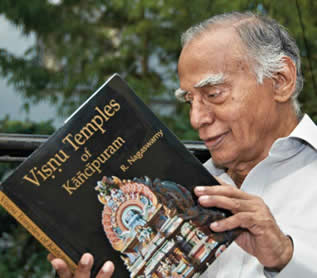Martand Martand is the famous temple of Surya in Kashmir It is Anatnag district near the modern village Matan, a prakrit name for Martand It is in a picturesque surrounding It was built by the famous king Lilitaditya muktapida around 750 The mian deity of Surya was made copper – Tamra swami A king named Kalasa known for his wicked ways, in around 1075 mutilated this Surya image but towards the end of his life he repented and went to the temple and presented a olden imgae of Martanda and within few died in front of this deity His son ws another stupid nd extravagant ruler who robbed temples for treasures but was afraid of Martand and and Ranesa around 1100 During the reign of Jayasimha in 1150 a battle was fought in front of the temple . Sanjapala the commader under the king, fell on the ground in the battle but was immediately carried by his sons inside the Martanda temple prakara. These informations are provided byKalhana in his Raja tarangini. Around 1400 the temple of Martanda was destroyed by the sultan Sikandar, he destroyer of temples, and the main image was destroyed. The temple ceased to be a place of worship since then though the next ruler Sultan Zainul Abdin was tolerant and benevolent ruler. In 1554 a severe Earth quake shattered Kashmir but Martand stood with out any damage. It is recorded that Vijayesvara, Maartanda, and the Varaha kshetra were not affected because of their Sanctity. Around 1575, The Mughal Emperor Akbar conquered Kashmir but the temple of Martanda was already in ruins. Akbar visited Martnda, visited Brahmins and gifted Cows adorned with pearls and gold to the Brahmins. It was the Hindu traditional Godana that Akbar made at Martanda. According to the Kashmiri text Nila mata purana, Maratanda was a tirtha of Martanda. According to 19th cent travelers the Martand temple was called the Palace of Pandavas. Cunningham was the First to give a detailed account of this Great temple in ruins, followed by James Fergusson who were great admirers of Hindu temples. The majestic temple has a garbhagraha, an antarala, and great madapa in front with an oblong prakara around it. The temple stands on a high platform with niches and sculptues on its inner façade. The inner platform has a number of koshtas in which 37 sculptures of Images like Siva, Vishnu, Brahma, Parvati, Ganga and Yamuna and Dvarapalas are seen. T the end is seen an image of Surya riding on a horse. He is accompanied by his two assistants Dandi and mundi The mandapa has an image on the ceiling , with six arms and holding a trisula. Othr rmblems are not viible There is also an image of seated Vishnu here. On top of the walls of the mandapa are two niches like shrines arrying mullti headed images of Vishnu. The one on the north has the three heads visible with the fourth at the back is not. The right face is that of a lion and the left is Varaha while the front is Vasudeva. The back obviously was Kapila. According to authorities the lion face is that os Samkarshana an d the Varaha face is that of Aniruddha. These faces represent the f0ur uhas of Vishnu The image on the South seems to be that Mahadeva which has also three heads the right face representing aghora and the left Vamadeva Uma vaktra. So the front is Tatpurusha. So both of them depict some form Bahirava There are other scuptures of interest. Equally interesting if the prakara.
|
Articles by Dr. R. Nagaswamy

Dr. Nagaswamy is an eminent Archaeologist and the First Vice Chancellor of Shri Chandrasekharendra Saraswathi Viswa Mahavidyalaya. His full bio-data is available here.